Cucumber plants are susceptible to various problems, diseases, viruses, and pests that can hinder their growth and reduce yield. Common issues include powdery mildew, characterized by white powdery spots on leaves, and downy mildew, which appears as yellowish spots and fuzzy growth on the undersides of leaves. Bacterial wilt, transmitted by cucumber beetles, causes sudden wilting and plant death. Viruses like cucumber mosaic virus lead to mottled leaves and stunted growth. Pests such as aphids, spider mites, and whiteflies can infest cucumber plants, sucking sap and spreading diseases. Effective management involves proper spacing, crop rotation, using resistant varieties, regular monitoring, and employing organic or chemical controls to mitigate these threats. This page covers some of the more common issues with growing cucumber plants.
Powdery Mildew
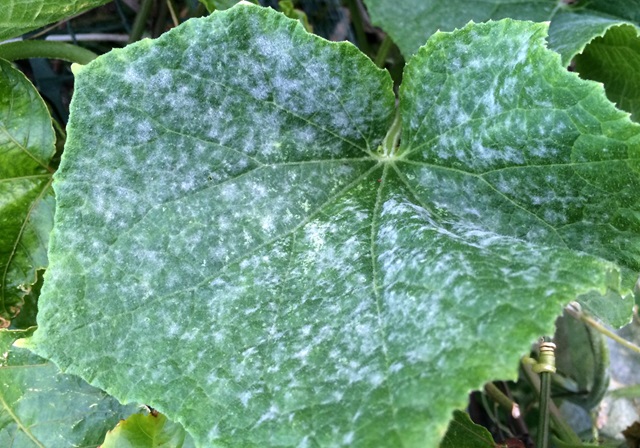
Powdery mildew is a common fungal disease affecting cucumber plants, characterized by white, powdery spots that appear on the leaves, stems, and sometimes fruits. These spots often start on the underside of the leaves but quickly spread, leading to a reduction in photosynthesis, which can stunt plant growth and reduce yield. The disease thrives in warm, dry conditions and can spread rapidly in crowded plantings with poor air circulation. To manage powdery mildew, it is essential to practice good garden hygiene, such as removing infected plant debris, spacing plants adequately, and providing proper watering. Fungicides can also be used as a preventive measure or to control existing infections. Additionally, selecting resistant cucumber varieties can help reduce the incidence of this disease.
Symptoms:
- White, powdery spots on leaves, stems, and fruit.
Causes:
- Caused by fungal pathogens (e.g., Erysiphe cichoracearum or Podosphaera xanthii).
- High humidity and poor air circulation.
Remedies and Preventive Measures:
- Remove and destroy affected plant parts.
- Apply fungicides labeled for powdery mildew.
- Ensure good air circulation by spacing plants properly.
- Water plants at the base, avoiding foliage.
Downy Mildew
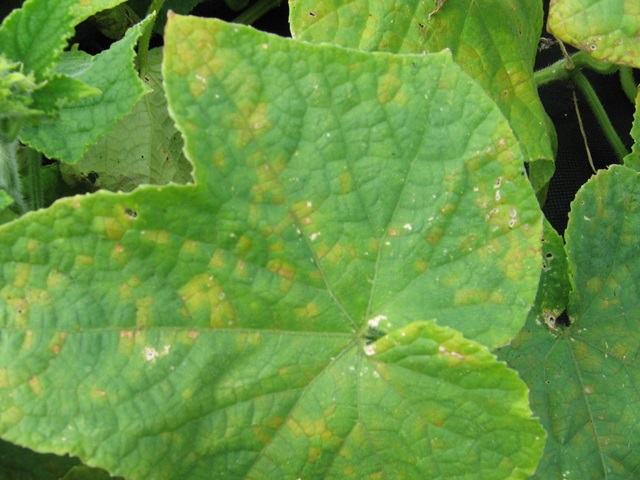
Downy mildew on cucumber plants is a destructive disease caused by the pathogen Pseudoperonospora cubensis. It thrives in humid, wet conditions and primarily affects the leaves of the plants, causing yellow angular spots that eventually turn brown and necrotic. These spots are often bordered by leaf veins, giving them a distinct angular appearance. The undersides of infected leaves may display a purplish-gray mold, particularly in the early morning or during humid conditions. The disease can severely reduce the plant's photosynthetic capacity, leading to stunted growth and diminished yield. Effective management includes using resistant cucumber varieties, practicing crop rotation, ensuring good air circulation, and applying appropriate fungicides when conditions favor disease development. Regular monitoring and early intervention are crucial to control the spread of downy mildew.
Symptoms:
- Yellow spots on upper leaf surfaces.
- Grayish-purple mold on the undersides of leaves.
Causes:
- Caused by the oomycete Pseudoperonospora cubensis.
- Wet, humid conditions.
Remedies and Preventive Measures:
- Remove infected leaves.
- Apply fungicides specific for downy mildew.
- Avoid overhead watering.
- Plant resistant cucumber varieties.
Cucumber Mosaic Virus (CMV)
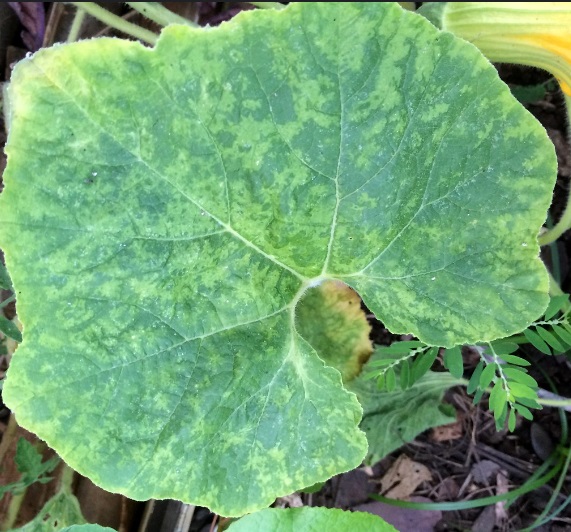
Cucumber Mosaic Virus (CMV) is a widespread plant pathogen affecting cucumber plants and numerous other crops. CMV is transmitted primarily by aphids and can also spread through mechanical means and seeds. Infected cucumber plants exhibit symptoms such as mosaic patterns on leaves, leaf distortion, stunted growth, and reduced fruit quality and yield. Managing CMV involves implementing integrated pest management strategies, including controlling aphid populations, using resistant cucumber varieties, practicing crop rotation, and maintaining proper sanitation to prevent the spread of the virus. There are no direct treatments for CMV, making prevention and early detection crucial for effective management.
Symptoms:
- Mosaic or mottling pattern on leaves.
- Distorted leaf shapes.
- Stunted growth.
Causes:
- Spread by aphids and other insects.
- Infected seeds or plants.
Remedies and Preventive Measures:
- Remove and destroy infected plants.
- Control aphid population with insecticides or natural predators.
- Use virus-free seeds and resistant varieties.
- Rotate crops and practice good sanitation.
Bacterial Wilt
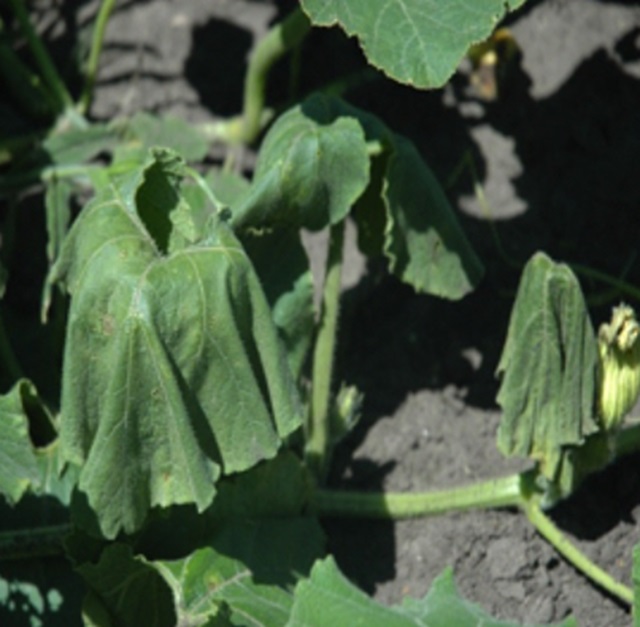
SyBacterial Wilt is a serious disease affecting cucumber plants, caused by the bacterium Erwinia Tracheiphila. It is transmitted primarily by cucumber beetles, which spread the bacteria while feeding on the leaves. Infected plants initially show wilting of individual leaves, which progresses to a permanent wilt of the entire plant. This occurs because the bacteria block the water-conducting vessels, preventing water from reaching the leaves and stems. There is no cure once a plant is infected; thus, prevention is crucial. This involves controlling cucumber beetles through physical barriers, insecticides, or attracting beneficial predators, and practicing good garden hygiene by removing infected plants promptly. Crop rotation and resistant cucumber varieties can also help mitigate the impact of this disease.mptoms:
- Sudden wilting of leaves during the day, recovering at night.
- Stems exude sticky bacterial ooze when cut.
Causes:
- Caused by the bacterium Erwinia Tracheiphila.
- Spread by cucumber beetles.
Remedies and Preventive Measures:
- Remove and destroy infected plants.
- Control cucumber beetles with insecticides or traps.
- Plant resistant varieties.
- Use row covers to protect young plants.
Anthracnose
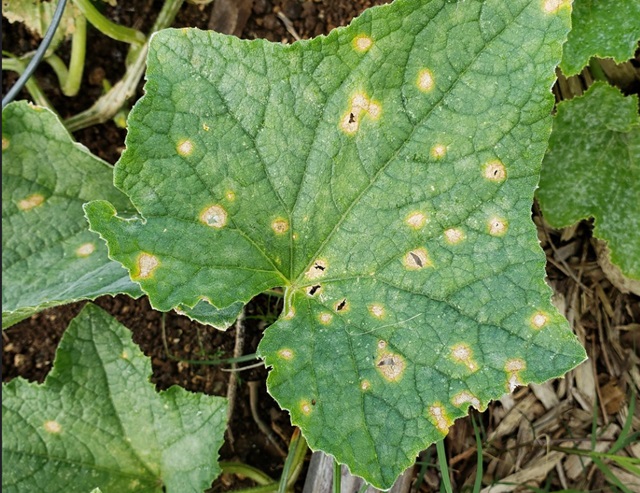
Anthracnose is a common fungal disease affecting cucumber plants, caused by the pathogen Colletotrichum orbiculare. It manifests as small, water-soaked lesions on leaves, stems, and fruits, which later enlarge and turn dark brown or black, often with a concentric ring pattern. This disease thrives in warm, wet conditions and can spread rapidly through splashing water, contaminated tools, and infected plant debris. To manage anthracnose, it is crucial to implement proper cultural practices such as crop rotation, using resistant varieties, ensuring good air circulation, and applying fungicides as needed. Regular monitoring and prompt removal of infected plant parts can also help in controlling the spread of this destructive disease.
Symptoms:
- Dark, sunken lesions on leaves, stems, and fruit.
- Leaves may turn yellow and drop.
Causes:
- Caused by the fungus Colletotrichum lagenarium.
- Wet, warm conditions.
Remedies and Preventive Measures:
- Remove and destroy affected plant parts.
- Apply fungicides labeled for anthracnose.
- Avoid overhead watering.
- Rotate crops and practice good sanitation.
Root-Knot Nematodes
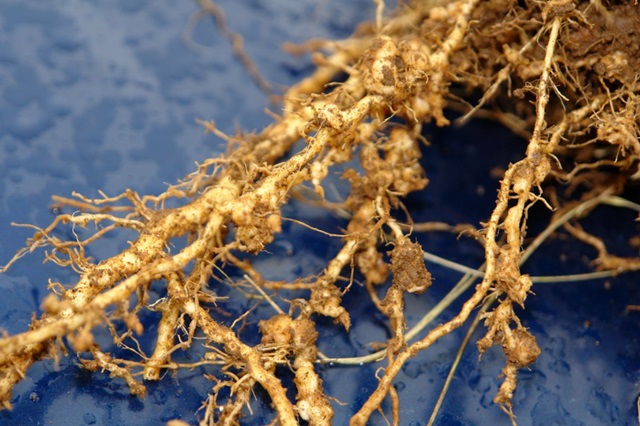
Root-Knot Nematodes (Meloidogyne spp.) are microscopic parasitic worms that significantly impact cucumber plants, causing reduced yields and poor plant health. These nematodes invade the roots, leading to the formation of characteristic galls or knots that interfere with the plant's ability to absorb water and nutrients. Symptoms of infestation include stunted growth, yellowing leaves, wilting, and overall poor vigor. Infestations are often worse in sandy soils and warm climates. Effective management strategies include crop rotation with non-host plants, use of resistant cucumber varieties, soil solarization, and the application of organic amendments or nematicides to reduce nematode populations. Integrated pest management practices are essential for maintaining healthy cucumber crops and minimizing the impact of Root-Knot Nematodes.
Symptoms:
- Knobby, swollen roots.
- Stunted growth and yellowing leaves.
Causes:
- Caused by microscopic nematodes (e.g., Meloidogyne spp.).
Remedies and Preventive Measures:
- Solarize soil before planting.
- Use nematode-resistant varieties.
- Rotate crops with non-host plants.
- Incorporate organic matter into soil to improve structure.
Fusarium Wilt
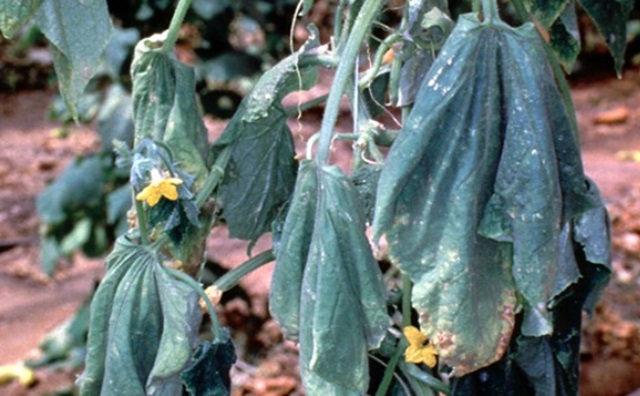
Fusarium Wilt is a destructive fungal disease affecting cucumber plants, caused by the pathogen Fusarium oxysporum f. sp. cucumerinum. The disease thrives in warm, moist conditions and can persist in soil for many years, making it difficult to eradicate. Infected plants exhibit symptoms such as yellowing and wilting of leaves, often starting from the base and progressing upwards. The vascular system of the plant becomes clogged, disrupting water and nutrient flow, which can lead to plant death. Management of Fusarium Wilt involves crop rotation with non-host plants, using resistant cucumber varieties, and improving soil drainage. Fungicides may offer limited control, and soil solarization can reduce pathogen levels in the soil.
Symptoms:
- Yellowing and wilting of lower leaves.
- Brown streaks in the stem when cut open.
Causes:
- Caused by the fungus Fusarium oxysporum.
- Warm soil temperatures.
Remedies and Preventive Measures:
- Remove and destroy infected plants.
- Use resistant cucumber varieties.
- Rotate crops and avoid planting cucumbers in the same spot year after year.
- Improve soil drainage.
Angular Leaf Spot
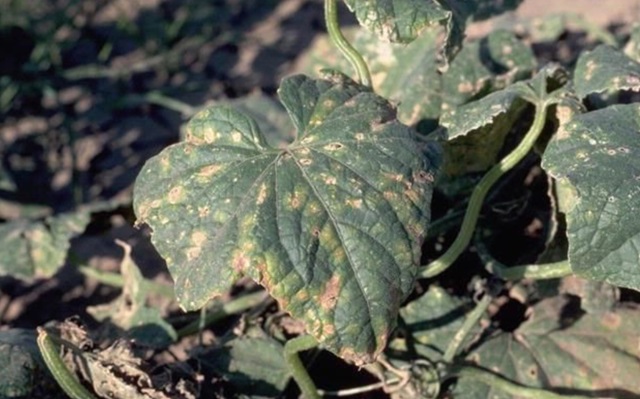
Angular Leaf Spot (ALS) is a bacterial disease affecting cucumber plants, caused by Pseudomonas syringae pv. lachrymans. This pathogen thrives in warm, moist conditions and spreads through water splashes, contaminated tools, and infected seeds. Symptoms include water-soaked lesions on leaves, which eventually become angular and turn brown with a yellow halo. These spots can merge, causing extensive leaf damage, defoliation, and reduced photosynthesis, ultimately impacting plant growth and yield. Managing ALS involves using disease-free seeds, practicing crop rotation, maintaining proper spacing for airflow, and applying copper-based bactericides when necessary. Implementing these measures can help mitigate the impact of ALS on cucumber crops.
Symptoms:
- Water-soaked lesions on leaves, often angular in shape.
- Lesions may become brown and dry out.
Causes:
- Caused by the bacterium Pseudomonas syringae.
- Wet and humid conditions.
Remedies and Preventive Measures:
- Remove and destroy affected plant parts.
- Apply copper-based bactericides.
- Avoid overhead watering.
- Rotate crops and practice good sanitation.
Gummy Stem Blight
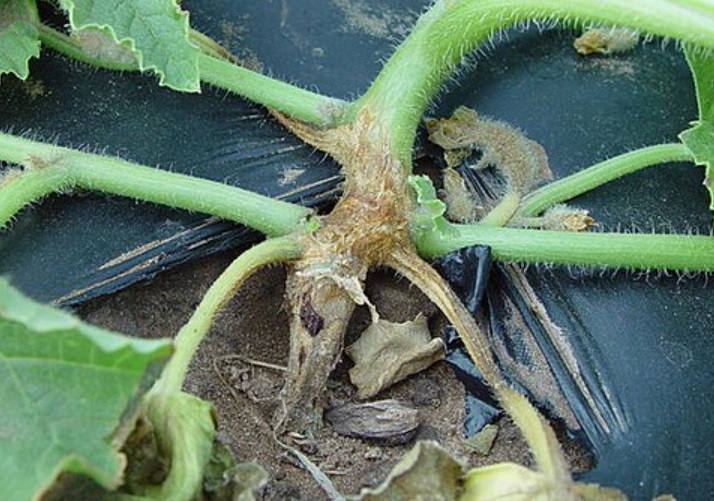
Gummy Stem Blight is a serious fungal disease affecting cucumber plants, caused by the pathogen Didymella bryoniae. It primarily manifests as dark, water-soaked lesions on stems, leaves, and fruits, which can exude a gummy, amber-colored substance. This disease thrives in warm, humid conditions and can lead to significant crop loss if not managed properly. Effective management strategies include crop rotation, using disease-free seeds, applying fungicides, and practicing good field sanitation. Early detection and prompt action are crucial to prevent the spread of Gummy Stem Blight and protect cucumber yields.
Symptoms:
- Brown or black lesions on stems and leaves.
- Sticky, gummy exudate from stems.
Causes:
- Caused by the fungus Didymella bryoniae.
- Wet and humid conditions.
Remedies and Preventive Measures:
- Remove and destroy infected plant parts.
- Apply fungicides labeled for gummy stem blight.
- Avoid overhead watering.
- Rotate crops and practice good sanitation.
Blossom End Rot
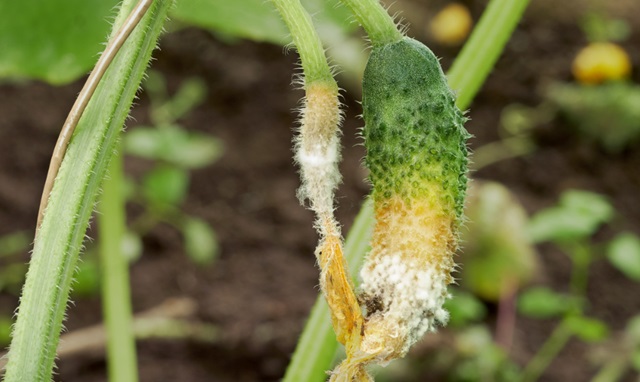
Blossom End Rot (BER) is a common physiological disorder affecting cucumber plants, characterized by water-soaked, sunken lesions at the blossom end of the fruit. This condition is primarily caused by calcium deficiency in the developing fruit, which can be exacerbated by irregular watering, drought stress, or excessive nitrogen fertilization. Although the soil may have adequate calcium levels, factors such as poor soil structure, root damage, or imbalanced nutrient uptake can impede calcium absorption. To prevent BER, consistent watering practices, mulching to retain soil moisture, and avoiding over-fertilization are crucial. Adding calcium supplements to the soil or foliar feeding with calcium solutions can also help mitigate this disorder. Regular monitoring and proper cultural practices can significantly reduce the incidence of Blossom End Rot in cucumber plants.
Symptoms:
- Dark, sunken spots on the blossom end of fruit.
- Fruit may rot and become unmarketable.
Causes:
- Calcium deficiency in the soil.
- Inconsistent watering.
Remedies and Preventive Measures:
- Maintain consistent soil moisture.
- Add calcium to the soil if necessary.
- Avoid excessive use of nitrogen fertilizers.
- Mulch to conserve soil moisture.
Cucumber Beetles
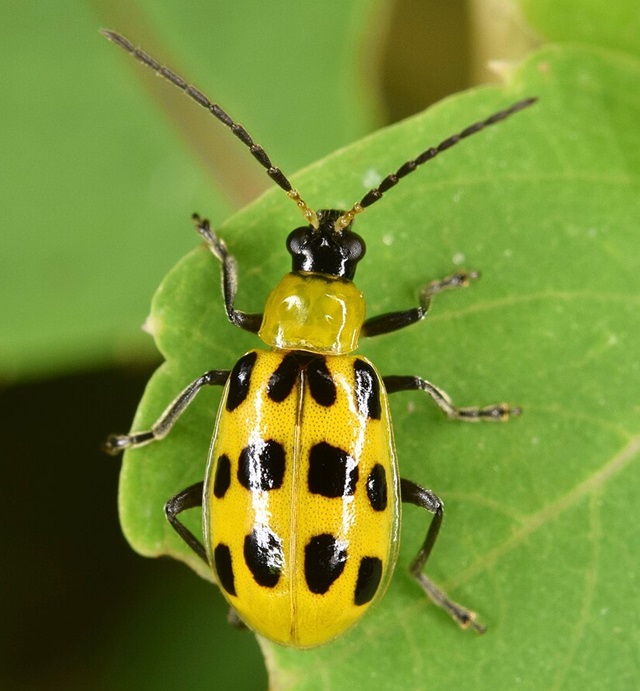 | 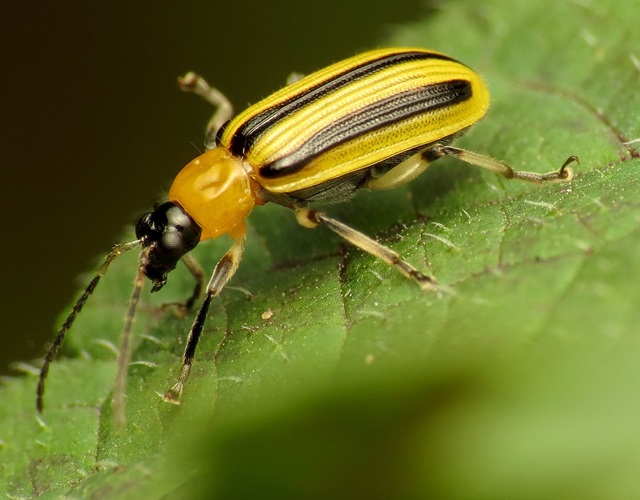 |
Cucumber beetles are common pests affecting cucumber plants, causing significant damage both directly and indirectly. These small, striped or spotted beetles feed on the leaves, stems, and fruits of cucumber plants, leading to defoliation and reduced plant vigor. Their feeding activity can result in holes and scarring on fruits, making them unmarketable. Additionally, cucumber beetles are vectors for bacterial wilt, a disease that can cause plants to wilt and die quickly. Managing cucumber beetles involves a combination of cultural practices, such as crop rotation and the use of row covers, as well as the application of insecticides and the introduction of natural predators. Early detection and prompt management are crucial to prevent extensive damage to cucumber crops.
Symptoms:
- Small, striped or spotted beetles on plants.
- Holes in leaves and damaged fruit.
Causes:
- Adult beetles feeding on foliage and fruit.
Remedies and Preventive Measures:
- Handpick beetles and destroy them.
- Use insecticides labeled for cucumber beetles.
- Apply row covers to protect young plants.
- Remove plant debris where beetles can overwinter.
Scab
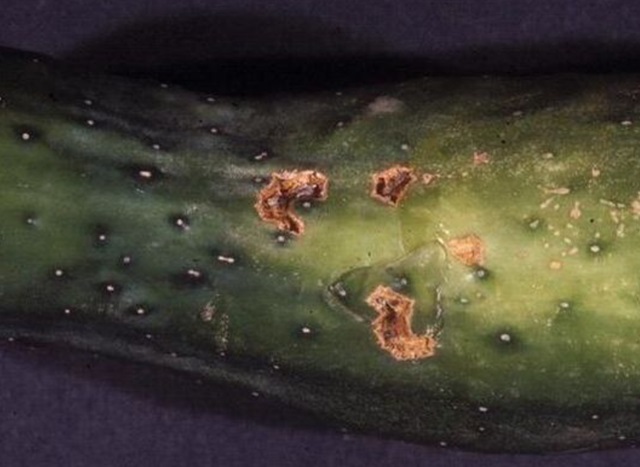
Cucumber scab, caused by the fungal pathogen Cladosporium cucumerinum, is a significant disease affecting cucurbit crops like cucumbers, melons, and squash. The disease manifests as small, sunken, water-soaked lesions on leaves, stems, and fruits, which later become dark and corky, often leading to deformed and unmarketable produce. Favorable conditions for cucumber scab include cool, wet weather and high humidity, which promote fungal spore germination and infection. Effective management strategies include crop rotation, resistant varieties, proper spacing for air circulation, and the application of fungicides as a preventive measure. Regular monitoring and immediate removal of infected plant material are also essential to control the spread of this disease.
Symptoms:
- Small, sunken spots on leaves and fruit.
- Lesions may become corky.
Causes:
- Caused by the fungus Cladosporium cucumerinum.
- Wet and cool conditions.
Remedies and Preventive Measures:
- Remove and destroy affected plant parts.
- Apply fungicides labeled for scab.
- Avoid overhead watering.
- Rotate crops and practice good sanitation.
Spider Mites
Symptoms:
- Tiny, spider-like pests on the undersides of leaves.
- Leaves become stippled, yellow, and may drop.
Causes:
- Hot and dry conditions favor mite infestations.
Remedies and Preventive Measures:
- Spray plants with a strong stream of water to dislodge mites.
- Use miticides labeled for spider mites.
- Introduce natural predators like ladybugs.
- Maintain adequate humidity around plants.
Whiteflies
Symptoms:
- Small, white insects on the undersides of leaves.
- Leaves may yellow and drop.
Causes:
- Infestation of whiteflies sucking plant sap.
Remedies and Preventive Measures:
- Use yellow sticky traps to capture whiteflies.
- Apply insecticidal soap or neem oil.
- Introduce natural predators like ladybugs and lacewings.
- Avoid over-fertilizing with nitrogen.
By following the recommended remedies and preventive measures for each issue, you can help ensure the health and productivity of your cucumber plants.

